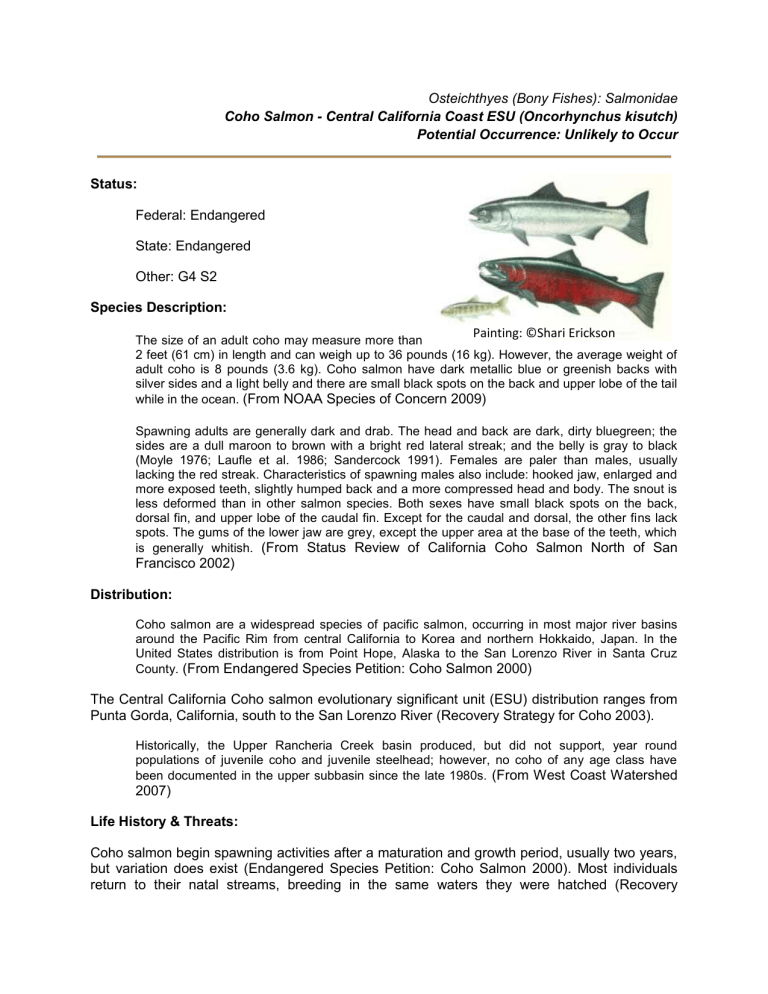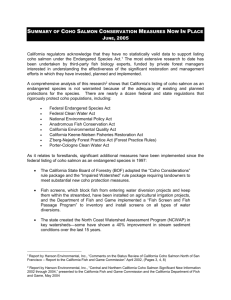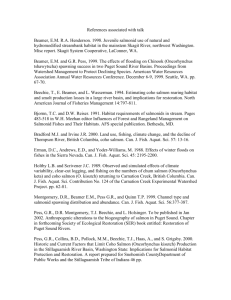ONKI Text

Osteichthyes (Bony Fishes): Salmonidae
Coho Salmon - Central California Coast ESU (Oncorhynchus kisutch)
Potential Occurrence: Unlikely to Occur
Status:
Federal: Endangered
©Pat Clayton
State: Endangered
Other: G4 S2
Species Description:
The size of an adult coho may measure more than
Painting: ©Shari Erickson
2 feet (61 cm) in length and can weigh up to 36 pounds (16 kg). However, the average weight of adult coho is 8 pounds (3.6 kg). Coho salmon have dark metallic blue or greenish backs with silver sides and a light belly and there are small black spots on the back and upper lobe of the tail while in the ocean. (From NOAA Species of Concern 2009)
Spawning adults are generally dark and drab. The head and back are dark, dirty bluegreen; the sides are a dull maroon to brown with a bright red lateral streak; and the belly is gray to black
(Moyle 1976; Laufle et al. 1986; Sandercock 1991). Females are paler than males, usually lacking the red streak. Characteristics of spawning males also include: hooked jaw, enlarged and more exposed teeth, slightly humped back and a more compressed head and body. The snout is less deformed than in other salmon species. Both sexes have small black spots on the back, dorsal fin, and upper lobe of the caudal fin. Except for the caudal and dorsal, the other fins lack spots. The gums of the lower jaw are grey, except the upper area at the base of the teeth, which is generally whitish.
Francisco 2002)
(From Status Review of California Coho Salmon North of San
Distribution:
Coho salmon are a widespread species of pacific salmon, occurring in most major river basins around the Pacific Rim from central California to Korea and northern Hokkaido, Japan. In the
United States distribution is from Point Hope, Alaska to the San Lorenzo River in Santa Cruz
County.
(From Endangered Species Petition: Coho Salmon 2000)
The Central California Coho salmon evolutionary significant unit (ESU) distribution ranges from
Punta Gorda, California, south to the San Lorenzo River (Recovery Strategy for Coho 2003).
Historically, the Upper Rancheria Creek basin produced, but did not support, year round populations of juvenile coho and juvenile steelhead; however, no coho of any age class have been documented in the upper subbasin since the late 1980s. (From West Coast Watershed
2007)
Life History & Threats:
Coho salmon begin spawning activities after a maturation and growth period, usually two years, but variation does exist (Endangered Species Petition: Coho Salmon 2000). Most individuals return to their natal streams, breeding in the same waters they were hatched (Recovery
Strategy for Coho 2003). Minimal straying into other watersheds exists, mainly due to factors such as steam blockage (Recovery Strategy for Coho 2003).
In California, spawning mainly occurs from November to January although it can extend into
February or March if drought conditions are present (Shapovalov and Taft 1954). Shapovalov and
Taft (1954) noted that the females choose the spawning sites usually near the head of a riffle, just below a pool, where the water changes from a laminar to a turbulent flow and there is a medium to small gravel substrate. The female digs a nest (redd) by turning partly on her side and using powerful rapid movements of the tail to dislodge the gravels, which are transported a short distance downstream by the current. Approximately 100 or more eggs are deposited in each redd. The fertilized eggs are buried by the female digging another redd just upstream. (From
Status Review of California Coho Salmon North of San Francisco 2002)
Eggs hatch after 8-12 weeks of incubation, the time being inversely related to water temperature.
Hatchlings remain in the gravel until their yolk sacs have been absorbed, 4-10 weeks after hatching. Upon emerging, they seek out shallow water along the stream margins. As the fish continue to grow, they move into deeper water and expand their territories until, by July and
August, they are in deep pools.
(From Endangered Species Petition: Coho Salmon 2000)
Out-migration in small California streams typically peaks from mid-April to mid-May, if conditions are favorable. Migratory behavior is related to rising or falling water levels, size of fish, day length, water temperature, food densities and dissolved oxygen levels.
(From Endangered Species
Petition: Coho Salmon 2000)
Oceanic coho tend to school together. Although it is not known if the schools are mixed, consisting of fish from different streams, fish from different regions are found in the same general areas. Adult coho salmon are primarily piscivores, but shrimp, crabs and other pelagic invertebrates can be important foods in some areas.
(From Endangered Species Petition:
Coho Salmon 2000)
Reported distribution of coho salmon has ranged from 15 to 28 streams within the Navarro River watershed (Brown and Moyle 1991; Brown et al. 1994; Adams et al. 1999; NMFS 2001a). CDFG
(2001b) estimated approximately 130 miles of coho salmon stream habitat were present in 1963.
The present distribution of coho salmon within the Navarro River watershed is substantially less than that recorded historically. Fourteen of the 19 streams listed by Brown and Moyle (1991) as historical coho salmon streams were surveyed in 2001. Coho salmon were observed in only six of these streams. Coho salmon populations are now restricted to the western portion of the watershed.
(From Status Review of California Coho Salmon North of San Francisco
2002)
Major threats to coho salmon revolve around human development and its associated impacts.
Habitat loss and fragmentation, artificial propagation and genetic lost between population diversity, pollution, habitat modification, over fishing, and climatic variation all have major impacts on coho salmon population abundance and viability (Endangered Species Petition:
Coho Salmon 2000, Status Review of California Coho Salmon North of San Francisco 2002).
Central California coho salmon distribution within the Navarro watershed has been particularly impacted by logging, cattle grazing, drought, low flow conditions, and more recently viticulture
(Status Review of California Coho Salmon North of San Francisco 2002). Navarro watershed
CDFG surveys from the 50's and 60's reported numerous log barriers caused by accumulated debris from historical logging activities and are cited as potential barriers likely limiting distribution and overall production within the watershed (Status Review of California Coho
Salmon North of San Francisco 2002).
Habitat & Habitat Associations: Salmonids with potential to occur in the Study Area (Chinook,
Coho, and Steelhead) require a variety of habitats and habitat features to successfully reproduce (the following adapted from Smith 2010):
Upstream Migration of Adults : Sufficient streamflow to allow passage over shallow riffles, log jams, falls, etc.
Spawning : Sufficient streamflow over clean gravel, cool water temperature, depth, and cover for escape (usually a deep pool with cover).
Coho salmon spawn mostly in small streams where the flow is 2.9 - 3.4 cfs and the stream depth ranges between 3.94 and 13.78 inches, depending on the velocity (Gribanov 1948; Briggs 1953;
Thompson 1972; Bovee 1978; Li et al. 1979). On the spawning grounds, they seek out sites of groundwater seepage and favor areas where the stream velocity is 0.98 - 1.8 ft/s. They also prefer areas of upwelling. The female generally selects a redd site at the tail-out of a pool or head of a riffle are where there is good circulation of oxygenated water through the gravel.
(From
Status Review of California Coho Salmon North of San Francisco 2002)
About 85% of redds occur in areas where the substrate is comprised of gravel of 15cm diameter or smaller. In situations where there is mud or fine sand in the nest site, it is removed during the digging process. LWD also diversifies flows, reducing stream energy directed towards redds
(Naiman et al. 1992). Pockets of relatively stable gravels help protect redds from the scouring effects of high flows.
(From Status Review of California Coho Salmon North of San
Francisco 2002)
Optimal temperatures for development of embryos in the gravel are 43-50 degrees F, although eggs and alevins can be found in 40-70 degree F water. Dissolved oxygen levels should be above 8 mg/l for juveniles (Emmett, et al. 1991).
(From Endangered Species Petition: Coho
Salmon 2000)
Rearing and Overwintering : Cover for escape (undercut banks, logs, pools, surface turbulence, unburied cobbles), suitable water quality (temperature, oxygen, clarity), and enough light for algal and insect production and sight feeding.
D eep pools and backwater habitat with good escape cover are particularly important for overwintering areas. Log jams may be valuable refuges during floods. Clear water between major storms to allow for feeding and growth
Juveniles prefer deep (greater than 3 feet), well shaded pools with plenty of overhead cover; highest densities are typically associated with logs and other woody debris in the pools or runs.
Juveniles require water temperatures that do not exceed 71-77 degrees F for extended time and oxygen and food (invertebrates) levels remain high. Preferred temperatures are 50-59 degrees F
(Hassler, 1987); preferred water velocities for juveniles are .25 to 1.5 feet per second depending on habitat. High turbidity is detrimental to emergence, feeding and growth of young coho
(Emmett, et al, 1991). Young and adult coho salmon are found over a wide range of substrates, from silt to bedrock.
(From Endangered Species Petition: Coho Salmon 2000)
Downstream Migration of Juveniles to the Ocean : Sufficient flow for safe passage. Prolonged flow to allow fish to feed and grow quickly in spring before migrating to the ocean. Clear water for rapid growth before and during migration.
Riparian Habitat: Canopy cover is important in maintaining shade for stream temperature control and in providing allochthonous materials in small to moderate sized streams for the aquatic habitats. Shading becomes less important as stream gradient and size increase. About 50% to
75% midday shade appears optimal for most small salmonid streams (USFWS 1986). Healthy, well-vegetated riparian areas helps control watershed erosion, reducing fine sediments and promoting adequate spawning grounds (USFWS 1986). McMahon and Hartman (1998) demonstrated a positive association between Coho Salmon and stream cover and pool complexity.
Conceptual Basis for GIS Model Development:
Without further field surveys to identify water flow (pool, run, riffle) and large woody debris needed by this species, GIS mapping of potential Coho Salmon habitat is limited. To define potential habitat in the Study Area, we mapped all permanent and intermittent watercourses with canopy coverage > 40%.
Potential Occurrence in the Study Area:
Habitat: Habitat quality in the upper Navarro Watershed is poor to moderate for salmonids in general (Myers et al. 1998). Habitat assessments for salmonids in the Preserve indicate that
Rancheria Creek has high stream temperatures, excessive fine sediments and little instream habitat and shelter (West Coast Watershed 2007).
Without adequate levels of large woody debris (LWD), instream habitat lacks pool frequency, depth, and complexity. In most surveyed streams in the [Navarro] watershed, there is low pool frequency and an excess of fast water habitat. These conditions are deleterious to both adult and juvenile salmonids. Lack of resting places may lead to adult mortality before spawning and lack of cover may lead to increased adult predation. Likewise, it can be difficult for juveniles to shelter during high flow events and they may be swept away.
(From West Coast Watershed 2007)
High temperatures may be due in part to the lack of a well-developed riparian overstory (which is patchy along the mainsteam of the creek) and early seasonal drawdown of surface water. The lower reaches of drainages into Rancheria Creek (e.g., Yale Creek) may, however, provide perennial surface water with cool temperatures needed by resident salmonids populations.
These drainages tend to be perennial, and often pooling in the summer, with dense forest and woodland canopy.
Habitat quality for Coho Salmon in the Preserve is poor to moderate (Figure 59). Coho are known to spawn in small coastal rivers and tributaries such as those found on the Preserve.
Their fry spend one to two years in freshwater and differ from Steelhead in their preference for slower-moving areas and pools. While pool frequency in the upper watershed is generally low, tributaries to Rancheria Creek may provide year-round, cool, slow-moving habitat needed by fry.
Nearest Occurrence :
Documented Occurrences in Galbreath Wildlands Preserve: Information on Coho occurrence is available for the Rancheria Creek subbasin. Between 1948 and 1952,
Coho and Steelhead were rescued during the summer from drying sections of Rancheria
Creek by California Department of Fish and Game (KrisWeb 2011). The maximum number of Coho rescued during this period were 51,466 fish in the summer of 1951. Six streams in the Rancheria Watershed subbasin were sampled between 1988 and 2002, but Coho were found only once, in Minnie Creek in 1996 (KrisWeb 2011). Surveys for salmonids in all Rancheria Creek sub-watersheds were conducted in 1998 (West Coast
Watershed 2007), and no Coho salmon were found.
Nearest Occurrence to Study Area: CDFG (2002) reports unpublished data from CDFG surveys (2001) that documents six streams in the lower Navarro watershed that currently support Coho spawning activities; mainstem Navarro River, Flynn Creek, South Branch of the North Fork, North Branch of the North Fork, Little North Fork, and John Smith
Creek.
Summary: This species is “Unlikely to Occur” in the Preserve because this species has not been documented in the upper Navarro Watershed in the last 10 years, indicating that habitat quality has deteriorated for this species. Aquatic and riparian restoration efforts could increase the likelihood of occurrence for this species.
References
California Department of Fish and Game. July 2000. Endangered Species Petition: Coho
Salmon ( Oncorhyncus kisutch ) California Endangered Species Act. <http://www.pcffa.org/ cesacoho.htm> Accessed July 2010.
California Department of Fish and Game. April 2002. Status Review of California Coho Salmon
North of San Francisco. <http://www.krisweb.com/biblio/cal_cdfg_cdfg_2002_cohostatus.pdf>
Accessed June 2010.
California Department of Fish and Game. 2003. Recovery Strategy for California Coho Salmon.
Report to the California Fish and Game Commission. p 2-9.
KrisWeb 2011. Klamath Resource Information System. Navarro River, Rancheria Creek.
< http://www.krisweb.com/index.htm
. Accessed 2011 May 9.
McMahon TE, Hartman GF. 1989. Influence of Cover Complexity and Current Velocity on
Winter Habitat Use by Juvenile Coho Salmon ( Oncorhynchus kisutch ). Can. J. Fish. Aquat. Sci.
46: 1551-1557.
National Marine Fisheries Service. 2009. Species of Concern NOAA.
<http://www.nmfs.noaa.gov/ pr/pdfs/species/cohosalmon_detailed.pdf> Accessed July 2010.
West Coast Watershed. 2007. Upper Rancheria Creek Preliminary Bio-geomorphic
Assessment. Mendocino County Resource Conservation District. <http://www.sonoma.edu/ preserves/docs/westcoastwatershed2007.pdf> Accessed June 2010.
Species Account Description: Neal Ramus & Emily Harvey




